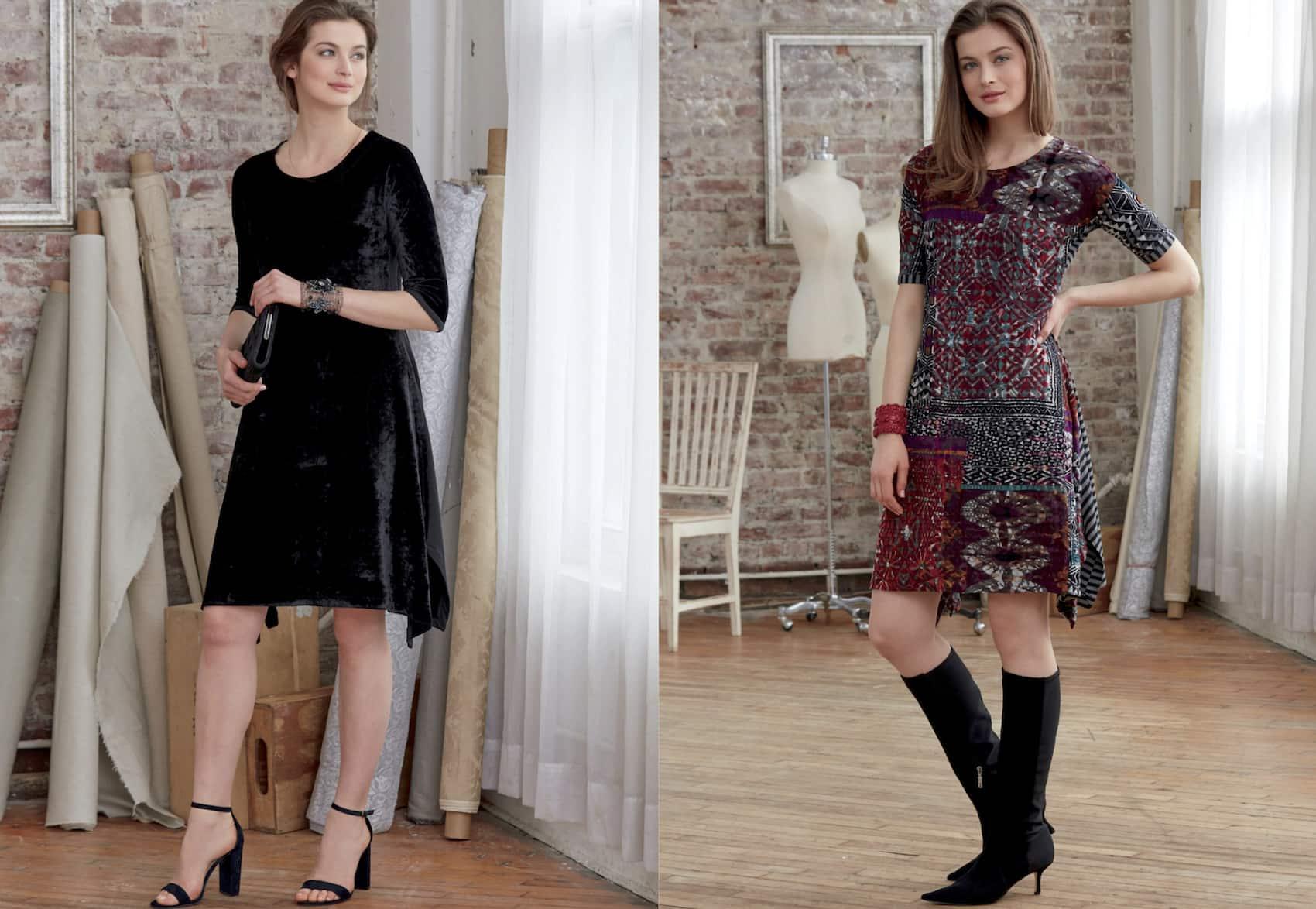The pattern company describes V9329 this way on the pattern envelope: “Pullover dresses, close-fitting through the bust, have pockets and sleeve length variations.”
It is that and much more.
The line drawings show the details.


Asymmetrical with back side piecing and asymmetrical shaped hem.
Semi-fitted so it just skims the bust, then floats over the figure. If you are full busted, it is a good idea to do a Full Bust Adjustment, (known as FBA).
The dress has cut-on dolman sleeves in two lengths. I’m on a search for what I refer to as a ‘non-dorky’ short sleeve for warmer weather, so the shorter sleeve on the dress is designed to be lightly fitted in an elbow length, a style that I’ve always liked in vintage clothes.
The sleeve is fitted with a slim cut. View A is designed to end just at the elbow. Adjust the sleeve ease to work with your fabric and arm measurements. HINT: a sleeve needs 1-2” ease at the bicep, depending on the size of your arm.
Sleeve View B is a ¾ length sleeve, also a flattering and easy to wear length - in all but the coldest weather I find myself rolling up sleeves, and in testing the pattern on different figures, this worked the best. Of course, you can lengthen the sleeve to wrist length as you wish.
The shoulder seam slants to the back which gives a smooth shoulder line. It features side seam pockets right where you want them and a faced neckline.
The length hits just below the knee, though on the 6’ tall models on the pattern envelope it much shorter. Adjust the length to suit your mood, the season, the fabric and your figure.
Asymmetrical with back side piecing and asymmetrical shaped hem.
Semi-fitted so it just skims the bust, then floats over the figure. If you are full busted, it is a good idea to do a Full Bust Adjustment, (known as FBA).
The dress has cut-on dolman sleeves in two lengths. I’m on a search for what I refer to as a ‘non-dorky’ short sleeve for warmer weather, so the shorter sleeve on the dress is designed to be lightly fitted in an elbow length, a style that I’ve always liked in vintage clothes.
The sleeve is fitted with a slim cut. View A is designed to end just at the elbow. Adjust the sleeve ease to work with your fabric and arm measurements. HINT: a sleeve needs 1-2” ease at the bicep, depending on the size of your arm.
Sleeve View B is a ¾ length sleeve, also a flattering and easy to wear length - in all but the coldest weather I find myself rolling up sleeves, and in testing the pattern on different figures, this worked the best. Of course, you can lengthen the sleeve to wrist length as you wish.
The shoulder seam slants to the back which gives a smooth shoulder line. It features side seam pockets right where you want them and a faced neckline.
The length hits just below the knee, though on the 6’ tall models on the pattern envelope it much shorter. Adjust the length to suit your mood, the season, the fabric and your figure.
Construction details & design tips.
- I stitched the entire garment using a walking foot.
- Sleeve hems are designed to be bound, so no hem allowances included, add them as needed.
- Cut facings and pocket in a lighter weight knit with similar stretch and stability as the fashion fabric.
- The side seam pockets are single layer, and stitched through the front fabric so they lie flat and smooth. I stitched the pockets with a ½” seam allowance, then trimmed close to the stitching so it would lie flat.

It is not necessary to ‘finish’ the edge of the facing, because the interfacing stabilizes the fabric. As there is no raveling, it makes the facing width even and the facing lies nice and flat. It is also an option to serge the facing edge.

On lighter weight knits like rayon/lycra, consider using any t-shirt neck finish.
For winter, you could use a cowl neck instead of the facing.
Velvet notes:
- Cut in one direction with nap going toward hem.
- Cut pockets and facings from a smooth flat knit
- Taking a cue from Bay Area designer, Carol Lee Shanks, we used the reverse side of the velvet for the back contrast piece.
- Baste using silk thread
- 505 Spray Adhesive is a secret ingredient when working with velvet.
- Secure seams from shifting by spraying the seam allowance with 505 spray. This is quick and works beautifully. It is a little-known secret of couture houses that for years the seamstresses have relied on similar spray adhesives for just this purpose
- Cover your work surface with paper, and carefully mask off the seam or hem allowance with paper.
- Spray a light, consistent amount of spray within the seam allowance, then carefully line up the edges of your fabric pieces.
Marcy’s Version
I used the same fabric we used on the pattern envelope…sold out, darn! I wear it with striped leggings and flat sandals.







